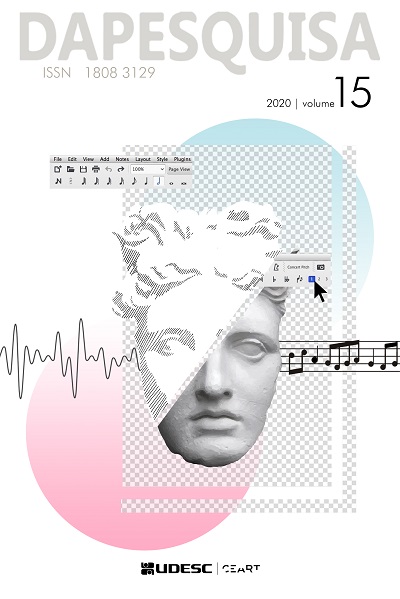Panic painting, photomontage and postmodernity
DOI:
https://doi.org/10.5965/1808312915252020e0012Keywords:
Fotografia - Efeitos especiais, Fotomontagem, Lima, Jorge de, 1893-1953Abstract
Observing Erwin Panofsky's (1955) indications about the way to interpret a work of art, this article proposes an approximation between A pintura em pânico (1943) photomontages book, composed by poet Jorge de Lima (1893-1953), and the postmodernity’s concept developed by Gianni Vattimo in The transparent society (1989). To this end, the avant-garde photomontage is understood as a subversion of the photographic principle itself considered as analogue to reality, and also as a rupture to painting as a pictorial composition’s canonic method. We also resort to the Gianni Vattimo’s established approximation between the concepts of shock in Walter Benjamin (1955) and Martin Heidegger’s stoss (1977), in order to suggest photomontage transcended its period and works as analogue to post modern’s condition, which is, above all, multiform.
Downloads
References
ADES, D. Photomontage. New York: Pantheon Books, 1976.
AMARAL JR., A. Jorge de Lima, fotógrafo supra-realista. O Cruzeiro, Rio de Janeiro, n. 36, 9 jul. 1938, p. 5 e p. 12. Disponível em: http://memoria.bn.br/DocReader/003581/23298. Acesso em: 25 fev. 2020.
ASSUNÇÃO, T. R. Fotomontagem e colagem poética em Jorge de Lima. Éspeculo: revista de estudios literários, Madri, ano 10, n. 31, nov.- fev., 2005-2006. Disponível em: http://www.ucm.es/info/especulo/numero31/jorlima.html. Acesso em: 02 mar. 2020.
BENJAMIN, W. A obra de arte na era de sua reprodutibilidade técnica. 1955. Website PhilArchive. Disponível em: https://philarchive.org/archive/DIATAT Acesso em: 27 fev. 2020.
ERNST, M. The Hundred Headless Woman (La Femme 100 têtes), 1929. Website MoMA. Disponível em: https://www.moma.org/collection/works/229544 Acesso em: 12. mar. 2020.
EXPOSIÇÃO CAIXA CULTURAL RIO. A Pintura em Pânico: fotomontagens Jorge de Lima. Rio de Janeiro, 15 mar. - 03 maio, 2010. Website Rio & Cultura. Disponível em: http://www.rioecultura.com.br/expo/expo_resultado2.asp?expo_cod=1486. Acesso em: 28 fev. 2020.
FABRIS, A. Fotomontagem e surrealismo: Jorge de Lima. Revista USP, São Paulo, n. 55, p. 143-151, 30 nov. 2002. DOI: https://doi.org/10.11606/issn.2316-9036.v0i55p143-151. Disponível em: http://www.revistas.usp.br/revusp/article/view/35154 Acesso em: 20 fev. 2020.
FABRIS, A. O desafio do olhar: fotografia e artes visuais no período das vanguardas históricas. São Paulo: Editora WMF Martins Fontes, 2011. v.2
FERNANDES, M. L. B. R. A Fotomontagem no Seculo XIX: da mecânica à narratologia. Revista Rhetorikê, Portugal, n. 4, p. 37-76, maio de 2012. Disponível em: http://www.rhetorike.ubi.pt/04/pdf/Rhetorike-04-03-fernandes.pdf. Acesso em: 19 fev. 2020.
HEIDEGGER, M. A origem da obra de arte. Lisboa: Edições 70, 1977.
LIMA, J. de. A pintura em pânico. Rio de Janeiro: [s. n.], 1943.
LYOTARD, J.-F. A condição pós-moderna. São Paulo: José Olympio, 1986.
MACHADO, L. Fotografia da capa do original n.177 de A pintura em pânico (1943). Biblioteca Brasiliana Guita e José Mindlin.
MONTEJO NAVAS, A. Fotografia e poesia (afinidades eletivas). São Paulo: Ubu Editora, 2017.
PANOFSKY, E. O Significado nas artes visuais. São Paulo: Perspectiva, 2014.
SACCHETTIN, P. A pintura em pânico: fotomontagens de Jorge de Lima. 2018. Tese (Doutorado em História) - Programa de Pós-Graduação em História, Universidade Estadual de Campinas, Campinas, SP, 2018. Disponível em: http://www.repositorio.unicamp.br/handle/REPOSIP/331878. Acesso em: 25 fev. 2020.
VATTIMO, Gianni. A sociedade transparente. Lisboa: Relógio D’água, 1992.
Published
How to Cite
Issue
Section
License
Copyright (c) 2020 Lorena Machado Macêdo Oliveira, Luciane Viana Barros Páscoa

This work is licensed under a Creative Commons Attribution 4.0 International License.
Authors who publish in this journal agree to the following terms:
The authors retain the copyright and grant the journal the right of first publication, with the study being simultaneously licensed under the Creative Commons Attribution-Noncommercial License, which allows the sharing of work with acknowledgment of authorship and initial publication in this journal.
This journal, following the recommendations of the Open Access movement, provides public access to all its content, following the principle that free access to research leads to a greater global exchange of knowledge.
Plagiarism in all its forms constitutes unethical publication behavior and is unacceptable. The Journal DAPesquisa reserves the right to use software or other methods of detecting plagiarism to analyze submitted works.





